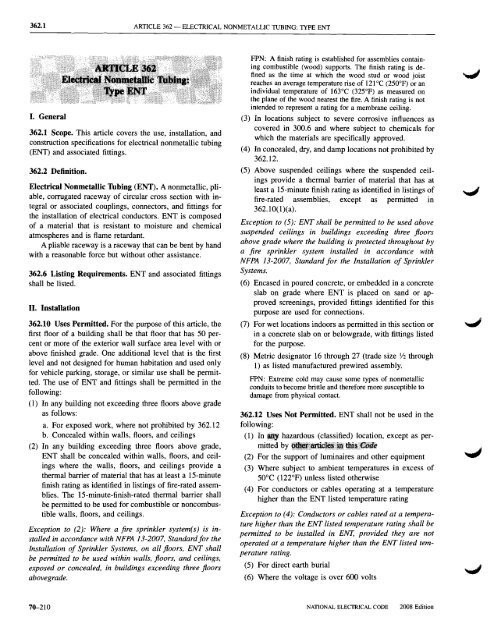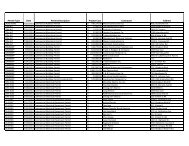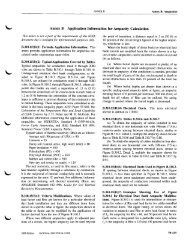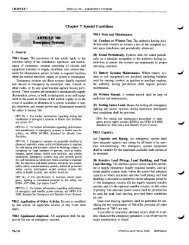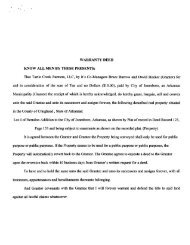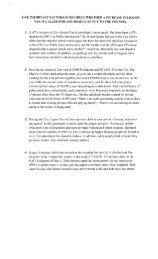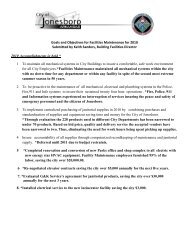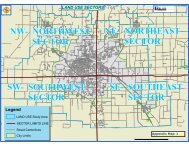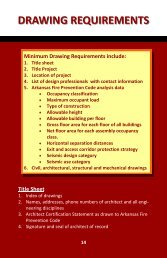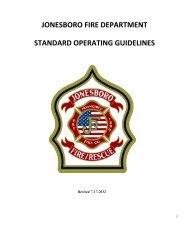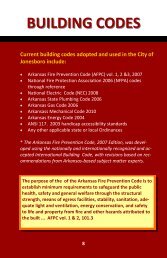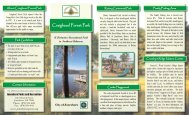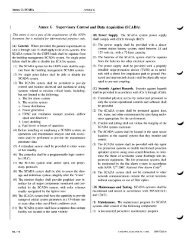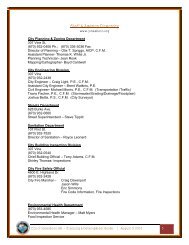Chapter 3 Wiring Methods and Materials
Chapter 3 Wiring Methods and Materials
Chapter 3 Wiring Methods and Materials
You also want an ePaper? Increase the reach of your titles
YUMPU automatically turns print PDFs into web optimized ePapers that Google loves.
362.1 ARTICLE 362 - ELECTRICAL NONMETALLIC TUBING: TIPE ENT<br />
I. General<br />
362.1 Scope. This article covers the use, installation, <strong>and</strong><br />
construction specifications for electrical nonmetallic tubing<br />
(ENT) <strong>and</strong> associated fittings.<br />
362.2 Definition.<br />
Electrical Nonmetallic Tubing (ENT). A nonmetallic, pliable,<br />
corrugated raceway of circular cross section with integral<br />
or associated couplings, connectors, <strong>and</strong> fittings for<br />
the installation of electrical conductors. ENT is composed<br />
of a material that is resistant to moisture <strong>and</strong> chemical<br />
atmospheres <strong>and</strong> is flame retardant.<br />
A pliable raceway is a raceway that can be bent by h<strong>and</strong><br />
with a reasonable force but without other assistance.<br />
362.6 Listing Requirements. ENT <strong>and</strong> associated fittings<br />
shall be listed.<br />
II. Installation<br />
362.10 Uses Permitted. For the purpose of this article, the<br />
first floor of a building shall be that floor that has 50 percent<br />
or more of the exterior wall surface area level with or<br />
above finished grade. One additional level that is the first<br />
level <strong>and</strong> not designed for human habitation <strong>and</strong> used only<br />
for vehicle parking, storage, or similar use shall be permitted.<br />
The use of ENT <strong>and</strong> fittings shall be permitted in the<br />
following:<br />
(I) In any building not exceeding three floors above grade<br />
as follows:<br />
a. For exposed work, where not prohibited by 362.12<br />
b. Concealed within walls, floors, <strong>and</strong> ceilings<br />
(2) In any building exceeding three floors above grade,<br />
ENT shall be concealed within walls, floors, <strong>and</strong> ceilings<br />
where the walls, floors, <strong>and</strong> ceilings provide a<br />
thermal barrier of material that has at least a IS-minute<br />
finish rating as identified in listings of fire-rated assemblies.<br />
The 15-minute-finish-rated thermal barrier shall<br />
be permitted to be used for combustible or noncombustible<br />
walls, floors, <strong>and</strong> ceilings.<br />
Exception to (2): Where a fire sprinkler system(s) is installed<br />
in accordance with NFPA 13-2007, St<strong>and</strong>ard for the<br />
Installation of Sprinkler Systems, on all floors, ENT shall<br />
be permitted to be used within walls, floors, <strong>and</strong> ceilings,<br />
exposed or concealed, in buildings exceeding three floors<br />
abovegrade.<br />
FPN: A finish rating is established for assemblies containing<br />
combustible (wood) supports. The finish rating is defined<br />
as the time at which the wood stud or wood joist<br />
reaches an average temperature rise of 121°C (250°F) or an<br />
individual temperature of 163°C (325°F) as measured on<br />
the plane of the wood nearest the fire. A finish rating is not<br />
intended to represent a rating for a membrane ceiling.<br />
(3) In locations subject to severe corrosive influences as<br />
covered in 300.6 <strong>and</strong> where subject to chemicals for<br />
which the materials are specifically approved.<br />
(4) In concealed, dry, <strong>and</strong> damp locations not prohibited by<br />
362.12.<br />
(5) Above suspended ceilings where the suspended ceilings<br />
provide a thermal barrier of material that has at<br />
least a IS-minute finish rating as identified in listings of<br />
fire-rated assemblies, except as permitted in<br />
362.1O(1)(a).<br />
Exception to (5): ENT shall be permitted to be used above<br />
suspended ceilings in buildings exceeding three floors<br />
above grade where the building is protected throughout by<br />
a fire sprinkler system installed in accordance with<br />
NFPA 13-2007, St<strong>and</strong>ard for the Installation of Sprinkler<br />
Systems.<br />
(6) Encased in poured concrete, or embedded in a concrete<br />
slab on grade where ENT is placed on s<strong>and</strong> or approved<br />
screenings, provided fittings identified for this<br />
purpose are used for connections.<br />
(7) For wet locations indoors as permitted in this section or<br />
in a concrete slab on or belowgrade, with fittings listed<br />
for the purpose.<br />
(8) Metric designator 16 through 27 (trade size Vz through<br />
1) as listed manufactured prewired assembly.<br />
FPN: Extreme cold may cause some types of nonmetallic<br />
conduits to become brittle <strong>and</strong> therefore more susceptible to<br />
damage from physical contact.<br />
362.12 Uses Not Permitted. ENT shall not be used in the<br />
following:<br />
(1) In ~ hazardous (classified) location, except as permitted<br />
by .1!!I~1'tWJ~~!lli~l]m~II.•~<br />
(2) For the support of luminaires <strong>and</strong> other equipment<br />
(3) Where subject to ambient temperatures in excess of<br />
50°C (122°F) unless listed otherwise<br />
(4) For conductors or cables operating at a temperature<br />
higher than the ENT listed temperature rating<br />
Exception to (4): Conductors or cables rated at a temperature<br />
higher than the ENT listed temperature rating shall be<br />
permitted to be installed in ENT, provided they are not<br />
operated at a temperature higher than the ENT listed temperature<br />
rating.<br />
(5) For direct earth burial<br />
(6) Where the voltage is over 600 volts<br />
70-210<br />
NATIONAL ELECTRICAL CODE<br />
2008 Edition


